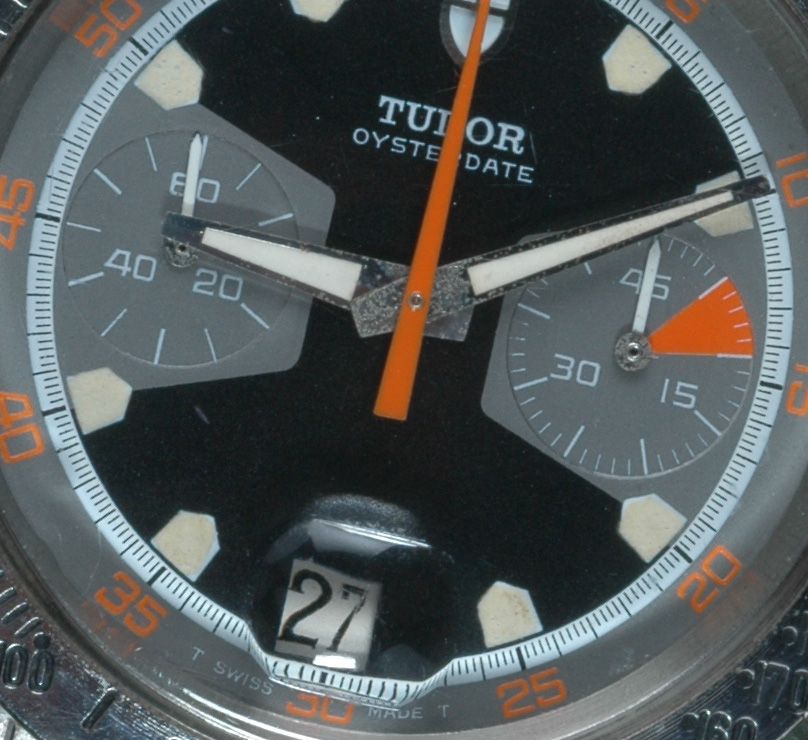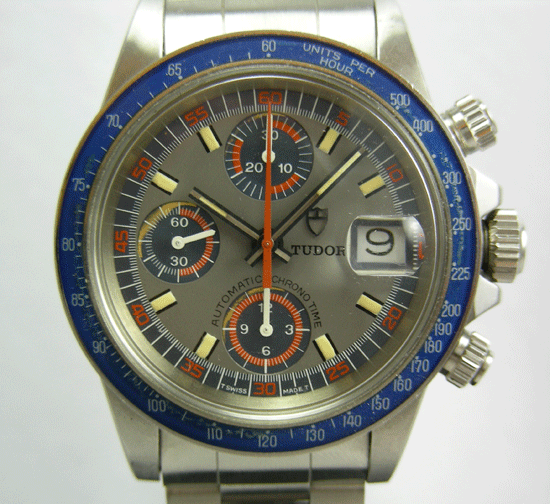In 1970 Tudor introduced their first Chronograph. The
reference 7031. The design of the Chronograph itself is very similar to that of
the Rolex counterpart. However there is a few differences. The cases are more
"fat" and taller than the Rolex versions. The watches feature a
manual wind movement and a two register chronograph function. What really make
these watches unique is the very iconic 1970's dial design. This design has
followed the next 2 variations of the Tudor Chronograph which is a prodcution
model thru 1970-1980.
TUDOR 7169/0. Chronograph. Early 1970's. Photos by MorganJ
Tudor Chronograph Reference 7031 / 7032.
The first Chronographs are called "Homeplate" by
collectors. This is due to the unique looking tritium markers. As far as we can
see they were introduced in 1970. The last ones seen have serials corresponding
to circa 1972. This is a very short production run - and very seldomly seen in
Rolex production lines.
TUDOR Chronograph Reference 7032. Photos by MarcusW. Note
the 2 register chrono dial and date at 6 o'clock.
The above 7032 sports the '500 tachy dial - solid fitted
bezel. The movement in the 7031/32 is a Valjoux 7734. Which is a manual wind
movement. Note the date window at 6 is uniquely "turned" and is in
fact a standard cyclope that is fitted turned half way compared to ordinary
Rolex cyclopes. The Reference 128 crystal is only used on the 2 register models
- 70xx and 71xx models.
TUDOR 7032. Caseback. Note the flat top 1st generation
pusher and original crown. Fat case. Photos by MarcusW
Bracelets on the Tudor Chronos is a sketchy area. Rolex in
general has had the option of up or downgrading bracelets depending on what the
customer wanted. However, in general - it is our experince that the 7031/32
were fitted on Rolex 7836 folded bracelets fitted with 380 endpieces. It is
quite interesting that they chose the 380 endpieces on these as it is actually
a quite poor fit. Later in the 1970s by the introduction of the Reference 9420
3 register chrono we begin seeing Ref 589 endpieces which are higher than the
380 - and that are flush fit to the case. Most collectors retrofit the 589
endpieces to also the older versions of 2 register chronos. All resources
indicate that 589 endpieces were in fact never factory delivered on the 2
register chronos. 589 endpieces are no longer in production. 380 and 380b are
sometimes seen in junk drawers at authorized dealers. Most dealer fit generic
501 endpieces at service. These are a poor fit.
TUDOR 7032. Side. Note the bent chrono counter hand.
Commonly done by old watchmakers to compensate for the crystal distortion.
Photos by MarcusW
Inverted dial color combination also exists. Its hard to
determine if the base grey or the base black is the rarest. it's a question of
condition. In general fewer black dial 70xx are seen. However, most of they
grey, have the classic spotting in the grey area.
TUDOR 7031. Note the 6263 style bezel and grey base color.
Photo by Bas.
TUDOR 7031. Note the 6263 style bezel and grey base color.
Photo by Bas.
TUDOR 7031. Note the 6263 style bezel and grey base color.
Photo by Bas.
TUDOR 7032. Note the 6263 style bezel and grey base color.
Photo by Bas.
1st Generation Homeplate variations:
Black base dial with grey area subdials.
Grey base dial with black area subdials.
6263 Style bakelite bezel.
6265 Style solid stainless bezel.
703x series feature a Valjoux manual wind 7734 (more
technical details in our Technical Resources subsite). The watch is water proof
to 5 bar / 50 meters. Unlike newer Rolex Daytonas the pushers may not be
operated under water.
Tudor Chronograph Reference 7149 / 7159 / 7169.
In 1972 Tudor altered the Chronograph line. It is unknown
why the 7031/32 had such a short production run, however the 71xx series
appeared approximatly two years after the old series started. The new version
was also a 2 register chronograph. It came in three case variations.
7149. Features a classic Rolex Daytona 6263 style bakelite
bezel. Exists in black or blue versions.
7159. Features a solid metal bezel similar to the Rolex 6265
bezel design. Tachymetre goes to '500.
7169. Features a metal bezel insert that is turnable. This
is a unique Tudor design. Exists in black and blue.
TUDOR 7159 Bezel. Note the matté surface. Extremely rare.
Photos by MorganJ.
TUDOR 7159 Bezel. Rear. Photo by MorganJ.
There is some confusion in the collectors community regd the
reference numbers. In general Rolex ran four digit reference numbers untill the
mid 1970's. Then introduced the fifth digit with a /. Eg. 7169/0. Shortly after
again - approx late 1970's Tudor used 5 digit reference numbers without the /.
During my research I have not found a structures system as to when these
references were altered for the specific models. It seems to me that the
different models had the changes applied over a period of time - perhaps as
much as 5 years. (1970-75). This means that you can see /0 reference numbers in
1972-73 for the chronos - but for the Submariners they did not change untill
75-76. The 71xx series has been seen with and without the / designation. 5
digit numbers without / (f.ex. 71690) does not exist for the 71xx series.
TUDOR 7169/0 Grey/Orange "Monte Carlo". Photo by
Morgan
Genereally when looking at Tudor chronographs with exotic
"Monte Carlo" dials (i.e. minimum 2 color combination dials) most
will notice that the dial decay follows certain patterns.
The blue 71xx series almost always see tritium marker decay
close to the inner 10+20 markers and 40+50 markers. This decay hits the rim of
the two chrono dials and in certain light you will almost certainly see paint
decay.
The Grey / Orange 71xx series almost always has light gray
spots on the large grey surface. The will look like small bubbles or spots of
water. It is unknown why Tudor chronos decay in this manner but considering the
massive paint problems seen on the Submariners - especially the 7021/16 and
early 9401/9411 which are made in the same time frame as the chronos, it is
logical to conclude that it is a general problem with tudors of this vintage.
TUDOR 7159/0. Circa 1972. Note the spots on the dial and
their conformity. Also note the original matté bezel.
A few examples showing no dial decay has been seen - this
may be due to age or small variations on production quality.
The 71xx series all feature a manual wind Valjoux Cal. 234,
17 ruby movement. The watches are water proof till 50 meters. Similar to the
703x series they feature the Cyclope 128 plexi crystal. Technical details are
listed in our technical section.
Tudor Chronograph Reference 9420 / 9430 / 94200 / 94300.
The 94xx series is the first automatic Tudor Chronograph. It
features the Valjoux Cal. 7750 workhorse. A classic movement still in use
today. When these were introduced in still a bit sketchy but the serial number
project indicates that they were introduced around 1976.
This means were a looking at the following timeline:
703x: 1970-72
71xx: Late 1972 - 1975
94xx: Circa 1976 - 1982.
Thirs third plexi glass Chronograph exists with two
variations of Monte Carlo dials. The early version (approx 800.000 serial to
920.000 serial) is similar in design to the older two register models. It
exists as black or blue.
From Watchcommander.com - Seen on their sales site. Ref
9420/0 Blue. rare
Tudor 9421/0. Rotatable Bezel. 3 Register MK1 Monte Carlo
Dial. Extremely Rare. Note the hands.
9420/0 - Bakelite fixed bezel
9421/0 - Rotating bezel
9430/0 - Fixed Metal bezel
94200 - Bakelite fixed bezel
94210 - Rotating bezel
94300 - Fixed metal bezel
The last Monte Carlo variation is shown below. Its seen in
general on watches with no / in the reference number. Over 900.000 serial. It
is not quite as big a premium as the older variations. Still a very handsome
dial.
TUDOR Chrono Time. Exotic dial. Reference 94300. By
SUBGMT.COM
TUDOR Chrono Time. Exotic dial. Reference 94300. By
SUBGMT.COM
TUDOR Chrono Time. Exotic dial. Reference 94300. By
SUBGMT.COM
TUDOR Chrono Time. Exotic dial. Reference 94300. By
SUBGMT.COM
TUDOR Chrono Time. Exotic dial. Reference 94300. By SUBGMT.COM
TUDOR Chrono Time. Exotic dial. Reference 94300. By SUBGMT.COM
Monte Carlo Watch Dial Variations
MK1. 2 Register
Homeplate Black base dial with grey area subdials.
Homeplate Grey base dial with black area subdials.
MK2. 2 Register
71xx Series, Grey base dial with orange secondary color
71xx Series, Grey base dial with blue secondary color
MK1. 3 Register
94xx/0 Series, Grey base dial with orange secondary color
94xx/0 Series, Grey base dial with blue secondary color
MK2. 3 Register
94xxx, Black base dial w. orange secondary color (very
little orange) 3 "open" subdials.



















